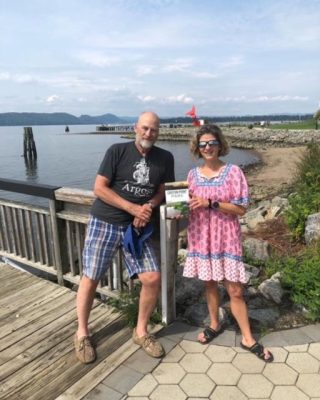Historical Odd Couple Combine to Tell the Tale of Croton Point
News Based on facts, either observed and verified directly by the reporter, or reported and verified from knowledgeable sources.
By Brian Kluepfel

It’s a tale of bootlegging, brickmaking and Benedictine betrayal. It’s a legacy of mammoths, manatees, menhaden and middens. Over six millennia, Croton Point has been a nexus of pre-colonial, colonial and American history.
Two local outdoor enthusiasts, one a retired Ossining police captain and the other a Croton-based writer and researcher, fueled with COVID -era intensity, have brought the point’s legacy to light in a new book, “Croton Point Park: Westchester’s Jewel on the Hudson.” (History Press, 2022)
Scott Craven and Caroline Ranald Curvan compare themselves to “the original Odd Couple,” or “Tony Soprano and Margaret Mead,” joked Craven.
“We couldn’t be more different but at the same time we share the same interests,” he said.
The tall, lanky ex-cop (a kayaker and bicyclist) and petite adjunct professor (an avowed runner) do indeed make an interesting pairing. However you describe them, Craven and Curvan have combined to produce an amusing and enlightening literary time capsule.
Craven, the Ossining town historian, is a familiar figure to anyone who visits the Ossining Public Library, where his loquaciousness and wealth of knowledge is appreciated by visitors to the reference desk. Curvan (rhymes with Ervin) provides a treasure trove of local lore on the Ossininghistoryontherun.com blog and recently led research on a PBS documentary about Laura Ingalls Wilder.
Interestingly enough, both authors claim that they “hate to write.” Gritting their teeth over a year’s worth of rewrites, they tag-teamed a manuscript that reminds us that “history surrounds us every day,” said Craven.
“We were able to keep each other’s noses to the grindstone,” Curvan noted.
Although both have specialties, the eight chapters spanning The Ice Age to the Environmental Movement were reviewed by each author multiple times.
Curvan and Craven also give credit to many local resources, including the Croton Historical Society and Westchester County Archives. John Philips and Bonnie Coe of the Croton Point Nature Center provided invaluable advice – and photos – as well.
“Any book like this is a group effort,” Curvan said. “It takes a few people to push it to the finish line.”
If writing is a chore to the duo, it doesn’t take much to get them going verbally. In a recent interview beside the Ossining Ferry terminal, with Teller’s Point as a backdrop, Curvan pointed across the river and said, “Look at that sheer rocky cliff there and you say ‘Oh that’s part of the Palisades, but…that was an old quarry, all chipped off by men. Right over that little dip there is where the (Knickerbocker) Ice Company had a ramp where they slid the ice down from Rockland Lake.”
The authors bring to light characters of ill repute, no repute and high standing, interspersing Craven’s humorous police reports and seal sightings with lively prose. Glacial-era alluvial flooding is “yoohoo from a firehose” and the cannon on Old Albany Post Road is “pointing uphill like an accusing finger” at GE’s plant in Crotonville, a notorious industrial polluter of the great river.
There’s even a short glossary helpful to the novice geologist (or perhaps Scrabble enthusiast), introducing brain-teasers like tombolo, drumlin and varve.
Villains John André and Benedict Arnold, as well as heroes like “Rifle Jack” Peterson and “Moses” Sherwood, burst forth in Curvan and Craven’s telling.
“I like writing historical stuff and bringing it to life, because I think history can be super boring,” said Curvan, who is currently teaching a history class at FIT.
It may be what you don’t know about Croton Point that will surprise you. There are 6,000-year-old shell middens from early indigenous communities; a brick factory once pumped out 64,000 WAU-stamped (William A. Underhill) bricks per day and ran the finished product – which still can be found all over the point – to river barges via a narrow-gauge railroad.
Excellence in grape growing was achieved by the Underhill family in the 1860s while they lived out of a mansion on the point built of Sing Sing prisoner-quarried marble. (The wine cellars are still there.) Legendary Ossining fisherman Henry Gourdine once brought in 12,000 pounds of fish from the river in a single day. As recently as 2006, a wayward manatee briefly roamed Haverstraw Bay.
The book concludes with activities that you, the reader, can pursue yourself on or near the point; biking and kayaking on routes vetted by Craven himself – his business card notes his title simply as “River Guy” – and a list of regularly-seen bird species on the peninsula. (Another naturalist factoid: Roger Tory Peterson launched the idea for the modern field guide, changing birding forever, during a Christmas Bird Count on Croton Point; James John Audubon’s engraver for the game-changing “Birds of America” folio prints, Robert Havell Jr. lived just uphill from the point.)
Current trends favor books like this.
“Schools are moving toward a model of place-based education,” said Craven of curricula which use local examples to hammer history home. “There’s a lot here if you just look for it.”
Scott Craven and Caroline Ranald Curvan will be discussing and signing their book at the Ossining Public Library’s Budarz Theater on Wednesday, Sept. 28 at 7 p.m.

Examiner Media – Keeping you informed with professionally-reported local news, features, and sports coverage.
